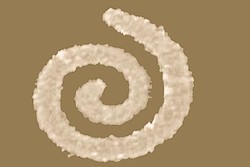Nano-spirals could be anti-counterfeit markers
Staff reporter, 08-Jun-2015
 Tiny gold "nano-spirals" have unique optical properties that could make them powerful tools against counterfeiting, say US researchers.
Tiny gold "nano-spirals" have unique optical properties that could make them powerful tools against counterfeiting, say US researchers.
Researchers at Vanderbilt University made the Archimedes' spirals and then used ultrafast lasers at Vanderbilt and the Pacific Northwest National Laboratory in Richland, Washington to characterize their optical properties.
Most other investigators who have studied the remarkable properties of microscopic spirals have done so by arranging discrete nanoparticles in a spiral pattern: similar to spirals drawn with a series of dots of ink on a piece of paper. By contrast, the new nano-spirals have solid arms and are much smaller.
"They are certainly smaller than any of the spirals we’ve found reported in the scientific literature," according to Roderick Davidson II, the Vanderbilt doctoral student who figured out how to study their optical behaviour.
As they are so small - smaller than the wavelength of visible light - they develop unusual optical properties. For example, when they are illuminated with infrared laser light, they emit visible blue light.
A number of crystals produce this effect, called frequency doubling or harmonic generation, to various degrees. The strongest frequency doubler previously known is the synthetic crystal beta barium borate, but the nano-spirals produce four times more blue light per unit volume.
When infrared laser light strikes the tiny spirals, it is absorbed by electrons in the gold arms. The arms are so thin that the electrons are forced to move along the spiral. Electrons that are driven toward the centre absorb enough energy so that some of them emit blue light at double the frequency of the incoming infrared light.
"This is similar to what happens with a violin string when it is bowed vigorously," said Stevenson Professor of Physics Richard Haglund, who directed the research.
"If you bow a violin string very lightly it produces a single tone. But, if you bow it vigorously, it also begins producing higher harmonics, or overtones. The electrons at the centre of the spirals are driven pretty vigorously by the laser's electric field. The blue light is exactly an octave higher than the infrared - the second harmonic."
The nano-spirals also have a distinctive response to polarized laser light. Linearly polarized light, like that produced by a Polaroid filter, vibrates in a single plane. When struck by such a light beam, the amount of blue light the nano-spirals emit varies as the angle of the plane of polarization is rotated through 360 degrees.
The effect is even more dramatic when circularly polarized laser light is used. In circularly polarized light, the polarization plane rotates either clockwise or counter-clockwise.
When left-handed nano-spirals are illuminated with clockwise polarized light, the amount of blue light produced is maximized because the polarization pushes the electrons toward the centre of the spiral. Counter-clockwise polarized light, on the other hand, produces a minimal amount of blue light because the polarization tends to push the electrons outward so that the waves from all around the nano-spiral interfere destructively.
The combination of the unique characteristics of their frequency doubling and response to polarized light provide the nano-spirals with a unique, customizable signature that would be extremely difficult to counterfeit, the researchers said.
So far, Davidson has experimented with small arrays of gold nano-spirals on a glass substrate made using scanning electron-beam lithography. Silver and platinum nano-spirals could be made in the same way.
Because of the tiny quantities of metal actually used, they can be made inexpensively out of precious metals, which resist chemical degradation. They can also be made on plastic, paper and a number of other substrates.
"If nano-spirals were embedded in a credit card or identification card, they could be detected by a device comparable to a barcode reader," said Haglund.
The frequency doubling effect is strong enough so that arrays that are too small to see with the naked eye can be detected easily. That means they could be placed in a secret location on a card, which would provide an additional barrier to counterfeiters.
The researchers also argue that coded nano-spiral arrays could be encapsulated and placed in explosives, chemicals and drugs - any substance that someone wants to track closely - and then detected using an optical readout device.
The results are reported in a paper published online by the Journal of Nanophotonics on May 21.
Related articles:



©
SecuringIndustry.com




 Tiny gold "nano-spirals" have unique optical properties that could make them powerful tools against counterfeiting, say US researchers.
Tiny gold "nano-spirals" have unique optical properties that could make them powerful tools against counterfeiting, say US researchers.